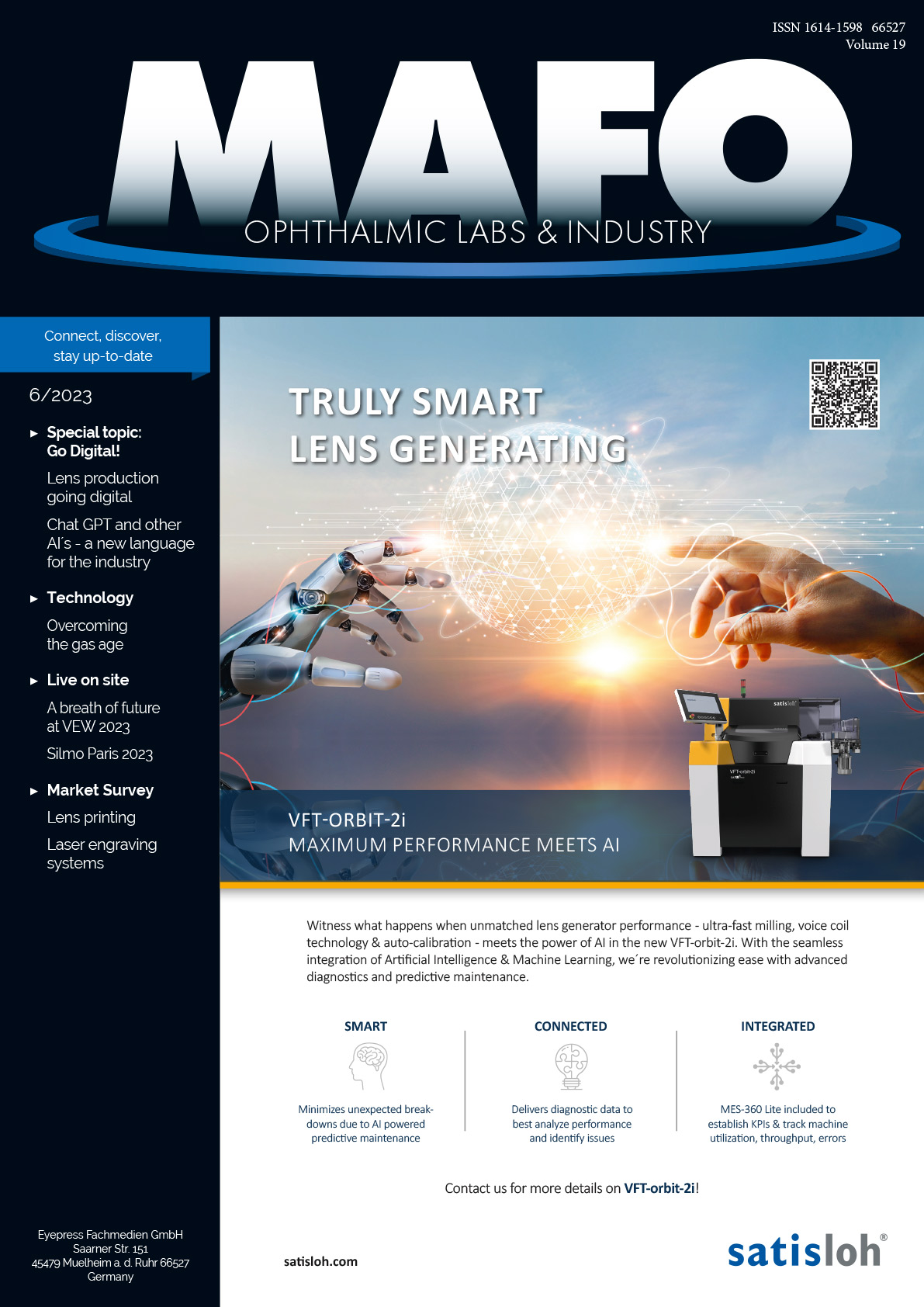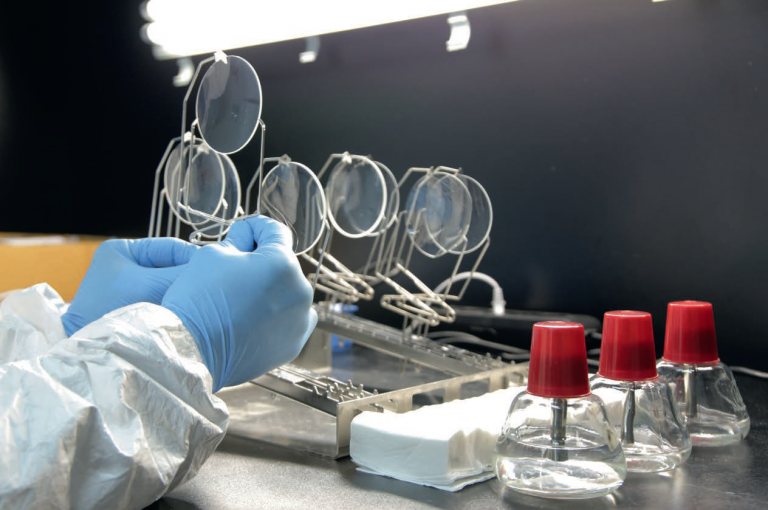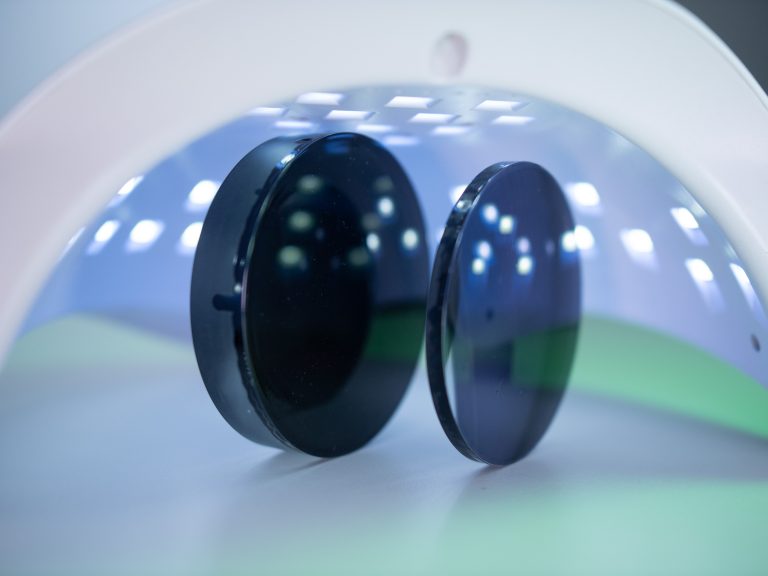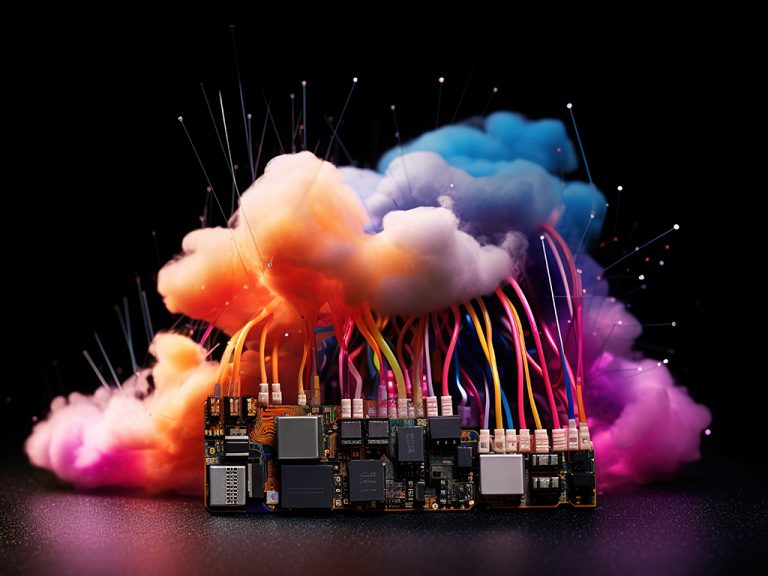Laser Engraving: Overcoming the gas age

Multiple photon absorption brings the laser processing for eyeglasses to the next level
The production of eyeglasses requires different laser marking processes. Semi-finished and especially free-form lenses require semi-visible functional laser engraving for position marks onto the uncoated surface. Besides these technical engravings, lasers can create visible brandings on spectacle lenses. Now, a new Diode Pumped Solid State (DPSS) UV concept was developed by 3D-Micromac, that should merge highest engraving quality and cost efficiency.
In the past, mainly excimer and CO₂ lasers covered those tasks. Excimer lasers’ UV wavelength proved optimal for manufacturing high-quality surface markings. Recently, economic considerations put pressure on the technical developed and established technology. That happened mainly due to the recent shortage of halogen gases. But also, intensive surveillance efforts caused by environmental, health, and safety reasons played an important role. Therefore, several alternative processes have been developed in the last years ‒ unfortunately, all of them were causing cutbacks on either engraving quality, lifetime, or material flexibility.
In 2023, 3D-Micromac developed a new DPSS UV concept that merged the highest engraving quality and superior cost efficiency for surface markings.
For more than twenty years, laser engraving has been the state-of-the-art engraving technique in the ophthalmic industry. Whereas excimer laser systems are especially suited for premium quality engraving, CO₂ lasers operate in low-cost production. These contemplations also apply to the laser system’s purchase price and operation costs. While CO₂ laser systems do not need much more than electricity and cooling water, excimer lasers need halogen gas for operation. With halogen gases becoming prohibitive up to temporarily unavailable on the market on several occasions in the last years, the search for alternatives began.
Fundamentals of laser processing
There are different laser-induced superficial material removal principles. One of them is laser ablation. Its mechanisms depend on:
- optical properties of the material (transparency, surface quality, chemical compounds)
- laser wavelength
- pulse length of the laser
- laser power, pulse energy, and energy density
As the transparent lens material must absorb the laser radiation for effective interaction between the laser and the lens material, it is only possible to engrave transparent materials with laser sources from ultraviolet (UV) to far infrared (IR) wavelengths. Meaning the recommended laser wavelengths need to be shorter than 400 nm (UV) or longer than 2 µm (IR).
In order to take advantage of linear absorption effects when using excimer lasers, pulse lengths in the nanosecond (ns) range need to be applied. By using an ultra-short-pulsed laser source, additional non-linear effects occur, generating precise and high-quality markings on transparent polymers. This opens the process window to higher wavelengths like 266 nm.
As a result, mainly two laser sources are in industrial use for laser engravings: excimer lasers in the UV wavelength range and CO₂ lasers in the IR wavelength range.
Nevertheless, several criteria must be considered to choose the most appropriate laser source for engraving: the requested engraving quality, reliability and lifetime of the laser source, and last but not least, the cost of operation.
”Cold” ablation vs. thermal structuring
Thermal ablation is the conventional way to achieve cost-effective engraving results in well-absorbing lens materials. However, as shown in Figure 2 (left), the longer laser pulses in the IR range are, the more they lead to severe thermal effects, such as melting and solidifying molten material. In addition, a heat-affected zone of some micrometers width, thermal stresses, cracks, and delamination of coatings may occur. During laser irradiation, the top layer of material heats up, and an ionization appears. All these facts influence the engraving quality.
Laser pulses in the UV or deep UV (DUV) range typically operate by pulse durations of 10-9 seconds. The energetic UV radiation and short nanosecond laser pulses achieve a precise engraving result. The main advantages are a minimum heating of the lens surface (Figure 2, middle) and a minimum heat-affected zone of some tens of nanometers width, no thermal stresses, cracks, and delamination of coatings (Figure 2, middle). Furthermore, UV laser engraving suits all polymer and glass lens materials.
A rather new approach to engraving in the ophthalmic industry are Diode Pumped Solid State (DPSS) lasers. Former DPSS lasers could not process common ophthalmic materials like CR39 since their wavelength was too long for linear interaction, and pulses were too long for non-linear effects. A new physical solution brought the possibility of multiple photon absorption by working with ultra-short pulses (down to 10-11 seconds) in this wavelength region. These pulses are short enough to compromise working at a wavelength of 266 nm. Therefore, the focus diameter is slightly smaller than working at 193 nm. (Figure 2, right) Due to the shorter pulse duration, the overall pulse effort is higher.
Solutions for ophthalmic lens marking
When in 2022 once again halogen gas became temporarily unavailable on the market, 3D-Micromac decided to develop a new laser engraving concept in the UV range. With their new microMARK RXe BLUE, the company provides a system that is equipped with an industry-proven DPSS laser source. This guarantees a significantly higher number of emitted laser pulses than similar classes of laser sources, thus ensuring premium engraving quality and cost-efficiency advantages.
As mentioned above, DPSS lasers have several advantages over other laser types, such as compactness, efficiency, costs of purchase, and reduced maintenance efforts. Furthermore, no halogen gas is required to operate the laser system. As a result, customers benefit from low investment and operating costs and fewer environmental, health, and safety risk management restrictions.
With the new laser engraving system, engraving test rows have been carried out on various commercially available ophthalmic lens materials together at multiple production facilities. The result: The engraving quality of the new DPSS laser system has clearly achieved the same standard as common excimer laser systems.
Figure 3 compares laser engraving results on CR39. On the left side, there are engraving results shown that are created with several excimer laser systems available in the market. On the right side (last row), the engraving result of the new 355 nm DPSS laser system is depicted. The pictures visualize the engraving qualities of functional and branding engravings on AR- and super-hydrophobic lenses.
It was shown that the DPSS laser source has created high-quality engravings with virtually no heat influence, melting, or material contamination on the surrounding material, making the engraving comparable in quality to excimer laser markings.
Excimer laser engraving quality at CO2 laser costs
As shown above, DPSS laser engraving systems are a considerable alternative to excimer laser engraving systems quality-wise. Additionally, due to their technical characteristics, using DPSS lasers opens the door to achieving excimer laser engraving quality by ownership costs comparable to CO₂ laser engraving systems.
The key drivers for this massive potential cost reduction are the DPSS lasers themselves. First, DPSS laser sources cost an average of 20% less than excimer laser sources that provide the same engraving results. Second, when working with DPSS laser sources, there is neither a need for gas supply systems nor gas safety equipment. Third, the cost for essential laser equipment, such as beam guidance and optical motion control, can be cut off due to the different technical approaches between excimer and DPSS laser engraving systems. Altogether, that leads to a CaPex (Capital Expenses) reduction of up to 20%.
Furthermore, switching to a DPSS laser engraving system can reduce the cost of ownership significantly. It is evident that without a gas supply system, material and labor costs for changing the gas necessary for operating an excimer laser become obsolete. In addition, the laser optics of DPSS lasers are more durable, which results in longer maintenance intervals. Another advantage of DPSS laser sources is that no laser tubes are installed, making a change during lifetime, differing from excimer lasers, unnecessary. Moreover, the DPSS laser source has a minimum lifetime of 5 billion shots, which is about 1.5 to 2.5 times higher than the lifetime of an excimer laser source.
All these factors can lead to a reduction of ownership costs of up to 60% compared to an excimer laser system – plus reduced downtimes and higher yield – in addition to saved labor, material, and service costs, as shown above. Under the cost of ownership view, exchanging existing laser equipment at the end of laser lifetimes can return the investment in less than two years.
Conclusion
DPSS lasers working in the UV range are an excellent alternative to CO₂ or excimer laser systems for laser engraving of ophthalmic lenses. With these systems, it is possible to achieve high-quality laser engravings. DPSS UV lasers are suitable to engrave all polymer materials from CR39 through high-index glasses, polycarbonate, and even glass lenses. Engraving intensity and contrast can vary according to customer demands. A comparison of investment and operational costs shows a significant advantage of DPSS UV lasers over excimer lasers for lens engraving. Thus, DPSS UV systems qualify as very interesting engraving method for all kinds of lenses with low investment and consumption costs and high-quality engravings. Furthermore, no gas is required to operate the laser system.
Outlook AR / VR
The eyeglass industry, meanwhile, is ready for the next big thing: Augmented reality (AR), or virtual reality products (VR), mix digital and established technologies with ophthalmic technologies. Displays are integrated inside glasses, allowing users to see the natural world and the virtual image in parallel. Among the most significant technological challenges associated with AR is the optical design of appropriate devices. The so-called optical combiner, which combines the real-world image with the virtual image generated by a display or projector, is at the heart of any AR device.
Already well known to the industry for decades, such combiners have not been suitable for consumer all-day use regarding especially their form. Waveguide technology offers a potential solution to this: Flat substrates made of optical grade glass serve to guide the image parallel to the waveguide’s surface while simultaneously allowing light to pass through perpendicular to the waveguide’s surface. Thus, a large portion of performance-defining parameters depend on the waveguide material and its specifications, such as refractive index, specific density, transmission, homogeneity, flatness, warpage, etc.
Although still in its infancy, the AR industry needs to consider lifetime and reliability issues, which are tied to product robustness on the one hand and processing yield on the other hand. In 2023, Schott and 3D-Micromac have optimized a laser-based separation process for cutting augmented reality (AR) eyepieces made of high-index glass that achieves high and predictable bending strength. Combining competencies in material science and equipment building significantly advanced the understanding of high-strength and high-throughput cutting of high-index glass and other transparent materials used in AR eyepieces. 3D-Micromac integrated the process into a modular machine concept scalable from lab applications to mass production.
Mandy Gebhardt Robin Zimny Claudia Radelow
This article was written by a team of authors working at 3D-Micromac. Mandy Gebhardt (Team Leader Marketing Scia systems and former Team Leader at 3D-Micromac), Robin Zimny (Head of Customer Service) and Claudia Radelow (Team Leader Marketing). With almost 200 laser engraving systems installed worldwide since 2004, 3DMicromac has an extensive experience in ophthalmic lens production. A worldwide available service team supports customers throughout the life cycle of the systems. In addition, the company has a fully equipped application laboratory with experienced process engineers, which support customers in feasibility tests, process development, and realization of customized solutions.














